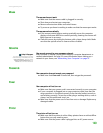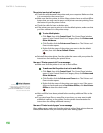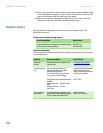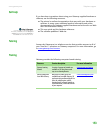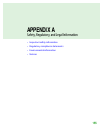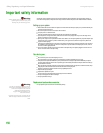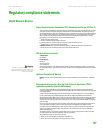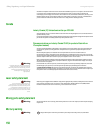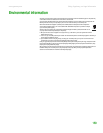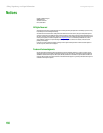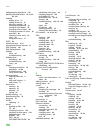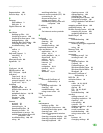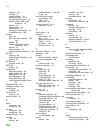
Safety, Regulatory, and Legal Information
www.gateway.com
157
Regulatory compliance statements
United States of America
Federal Communications Commission (FCC) Unintentional emitter per FCC Part 15
This device has been tested and found to comply with the limits for a Class B digital device, pursuant to Part15 of the FCC rules. These limits
are designed to provide reasonable protection against harmful interference in a residential installation. This equipment generates, uses,
and can radiate radio frequency energy and, if not installed and used in accordance with the instructions, may cause harmful interference to
radio or television reception. However, there is no guarantee that interference will not occur in a particular installation. If this equipment
does cause interference to radio and television reception, which can be determined by turning the equipment off and on, the user is
encouraged to try to correct the interference by one or more of the following measures:
■
Reorient or relocate the receiving antenna
■
Increase the separation between the equipment and receiver
■
Connect the equipment to an outlet on a different circuit from that to which the receiver is connected
■
Consult the dealer or an experienced radio/TV technician for help.
Compliance Accessories: The accessories associated with this equipment are: shielded video cable when an external monitor is
connected. These accessories are required to be used in order to ensure compliance with FCC rules.
FCC declaration of conformity
Compliant device:
Gateway Profile
Responsible party:
Gateway, Inc.
7565 Irvine Center Drive
Irvine, CA 92618 USA
Caution
Changes or modifications not expressly
approved by Gateway could void the FCC
compliance and negate your authority to
operate the product.
This device complies with Part15 of the FCC Rules. Operation of this device is subject to the following two conditions: (1) this device may
not cause harmful interference, and (2) this device must accept any interference received, including interference that may cause undesired
operation.
California Proposition 65 Warning
Warning: This product contains chemicals, including lead, known to the State of California to cause cancer, birth defects or reproductive
harm.
Telecommunications per Part 68 of the Code of Federal Regulations (CFR 47)
(applicable to products fitted with USA modems)
Your modem complies with Part68 of the Code of Federal Regulations (CFR47) rules. On the computer or modem card is a label that
contains the FCC registration number and Ringer Equivalence Number (REN) for this device. If requested, this information must be provided
to the telephone company.
A telephone line cord with a modular plug is required for use with this device. The modem is designed to be connected to the telephone
network or premises wiring using a compatible modular jack which is Part 68-compliant. See installation instructions for details.
The Ringer Equivalence Number (REN) is used to determine the number of devices which may be connected to the telephone line. Excessive
RENs on a telephone line may result in the devices not ringing in response to an incoming call. In most areas, the sum of RENs should not
exceed five (5.0). To be certain of the number of devices that may be connected to a line, as determined by the total RENs, contact the local
telephone company.
If this device causes harm to the telephone network, the telephone company will notify you in advance that temporary discontinuance of
service may be required. The telephone company may request that you disconnect the equipment until the problem is resolved.
The telephone company may make changes in its facilities, equipment, operations, or procedures that could affect the operation of this
equipment. If this happens, the telephone company will provide advance notice in order for you to make necessary modifications to
maintain uninterrupted service.
This equipment cannot be used on telephone company-provided coin service. Connection to party line service is subject to state tariffs.
Contact the state public utility commission or public service commission for information.
When programming or making test calls to emergency numbers:
■
Remain on the line and briefly explain to the dispatcher the reason for the call.
■
Perform such activities in the off-peak hours such as early morning or late evenings.



